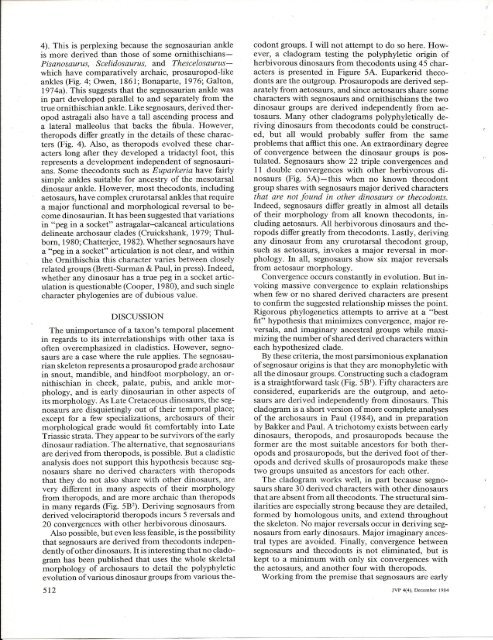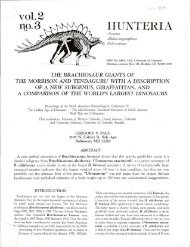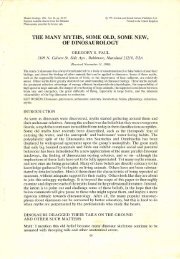THE SEGNOSAURIAN DINOSAURS: RELICS OF ... - Gregory S. Paul
THE SEGNOSAURIAN DINOSAURS: RELICS OF ... - Gregory S. Paul
THE SEGNOSAURIAN DINOSAURS: RELICS OF ... - Gregory S. Paul
You also want an ePaper? Increase the reach of your titles
YUMPU automatically turns print PDFs into web optimized ePapers that Google loves.
4). This is perplexing because the segnosaurian ankle<br />
is more derived than those of some ornithischians=-<br />
Pisanosaurus, Scelidosaurus, and Thescelosauruswhich<br />
have comparatively archaic, prosauropod-like<br />
ankles (Fig. 4; Owen, 1861; Bonaparte, 1976; Galton,<br />
1974a). This suggeststhat the segnosaurian ankle was<br />
in part developed parallel to and separately from the<br />
true ornithischian ankle. Like segnosaurs, derived theropod<br />
astragali also have a tall ascending process and<br />
a lateral malleolus that backs the fibula. However,<br />
theropods differ greatly in the details of these characters<br />
(Fig. 4). Also, as theropods evolved these characters<br />
long after they developed a tridactyl foot, this<br />
represents a development independent of segnosaurians.<br />
Some thecodonts such as Euparkeria have fairly<br />
simple ankles suitable for ancestry of the mesotarsal<br />
dinosaur ankle. However, most thecodonts, including<br />
aetosaurs, have complex crurotarsal ankles that require<br />
a major functional and morphological reversal to become<br />
dinosaurian. It has been suggestedthat variations<br />
in "peg in a socket" astragalar-calcaneal articulations<br />
delineate archosaur clades (Cruickshank, 1979; Thulborn,<br />
1980;Chatterjee, 1982).Whether segnosaurshave<br />
a "peg in a socket" articulation is not clear, and within<br />
the Ornithischia this character varies between closely<br />
related groups (Brett-Surman & <strong>Paul</strong>, in press). Indeed,<br />
whether any dinosaur has a true peg in a socket articulation<br />
is questionable (Cooper, 1980),and such single<br />
character phylogenies are of dubious value.<br />
DISCUSSION<br />
The unimportance of a taxon's temporal placement<br />
in regards to its interrelationships with other taxa is<br />
often overemphasized in cladistics. However, segnosaurs<br />
area case where the rule applies. The segnosaurian<br />
skeleton represents a prosauropod grade archosaur<br />
in snout, mandible, and hindfoot morphology, an ornithischian<br />
in cheek, palate, pubis, and ankle morphology,<br />
and is early dinosaurian in other aspects of<br />
its morphology. As Late Cretaceous dinosaurs, the segnosaurs<br />
are disquietingly out of their temporal place;<br />
except for a few specializations, archosaurs of their<br />
morphological grade would fit comfortably into Late<br />
Triassic strata. They appear to be survivors of the early<br />
dinosaur radiation. The alternative, that segnosaurians<br />
are derived from theropods, is possible. But a cladistic<br />
analysis does not support this hypothesis because segnosaurs<br />
share no derived characters with theropods<br />
that they do not also share with other dinosaurs, are<br />
very different in many aspects of their morphology<br />
from theropods, and are more archaic than theropods<br />
in many regards (Fig. SB2).Deriving segnosaurs from<br />
derived velociraptorid theropods incurs 5 reversals and<br />
20 convergences with other herbivorous dinosaurs.<br />
Also possible, but even less feasible, is the possibility<br />
that segnosaurs are derived from thecodonts independently<br />
of other dinosaurs. It is interesting that no cladogram<br />
has been published that uses the whole skeletal<br />
morphology of archosaurs to detail the polyphyletic<br />
evolution of various dinosaur groups from various the-<br />
512<br />
codont groups. I will not attempt to do so here. However,<br />
a cladogram testing the polyphyletic origin of<br />
herbivorous dinosaurs from thecodonts using 45 characters<br />
is presented in Figure SA. Euparkerid thecodonts<br />
are the outgroup. Prosauropods are derived separately<br />
from aetosaurs, and since aetosaurs share some<br />
characters with segnosaurs and ornithischians the two<br />
dinosaur groups are derived independently from aetosaurs.<br />
Many other cladograms polyphyletically deriving<br />
dinosaurs from thecodonts could be constructed,<br />
but all would probably suffer from the same<br />
problems that afflict this one. An extraordinary degree<br />
of convergence between the dinosaur groups is postulated.<br />
Segnosaurs show 22 triple convergences and<br />
11 double convergences with other herbivorous dinosaurs<br />
(Fig. SA)-this when no known thecodont<br />
group shares with segnosaurs major derived characters<br />
that are not found in other dinosaurs or thecodonts.<br />
Indeed, segnosaurs differ greatly in almost all details<br />
of their morphology from all known thecodonts, including<br />
aetosaurs. All herbivorous dinosaurs and theropods<br />
differ greatly from thecodonts. Lastly, deriving<br />
any dinosaur from any crurotarsal thecodont group,<br />
such as aetosaurs, invokes a major reversal in morphology.<br />
In all, segnosaurs show six major reversals<br />
from aetosaur morphology.<br />
Convergence occurs constantly in evolution. But invoking<br />
massive convergence to explain relationships<br />
when few or no shared derived characters are present<br />
to confirm the suggestedrelationship misses the point.<br />
Rigorous phylogenetics attempts to arrive at a "best<br />
fit" hypothesis that minimizes convergence, major reversals,<br />
and imaginary ancestral groups while maximizing<br />
the number of shared derived characters within<br />
each hypothesized clade.<br />
Bythese criteria, the most parsimonious explanation<br />
of segnosaur origins is that they are monophyletic with<br />
all the dinosaur groups. Constructing such a cladogram<br />
is a straightforward task (Fig. SBl).Fifty characters are<br />
considered, euparkerids are the outgroup, and aetosaurs<br />
are derived independently from dinosaurs. This<br />
cladogram is a short version of more complete analyses<br />
of the archosaurs in <strong>Paul</strong> (1984), and in preparation<br />
by Bakker and <strong>Paul</strong>. A trichotomy exists between early<br />
dinosaurs, theropods, and prosauropods because the<br />
former are the most suitable ancestors for both theropods<br />
and prosauropods, but the derived foot oftheropods<br />
and derived skulls of prosauropods make these<br />
two groups unsuited as ancestors for each other.<br />
The cladogram works well, in part because segnosaurs<br />
share 30 derived characters with other dinosaurs<br />
that are absent from all thecodonts. The structural similarities<br />
are especially strong because they are detailed,<br />
formed by homologous units, and extend throughout<br />
the skeleton. No major reversals occur in deriving segnosaurs<br />
from early dinosaurs. Major imaginary ancestral<br />
types are avoided. Finally, convergence between<br />
segnosaurs and thecodonts is not eliminated, but is<br />
kept to a minimum with only six convergences with<br />
the aetosaurs, and another four with theropods.<br />
Working from the premise that segnosaurs are early<br />
JVP 4(4), December 1984









